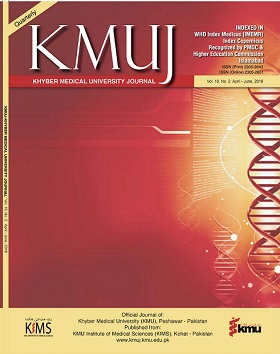FREQUENCY AND FACTORS ASSOCIATED WITH TOBACCO SMOKING AMONG YOUNG FEMALE STUDENTS IN PAKISTAN
Main Article Content
Abstract
ABSTRACT
OBJECTIVE: To evaluate the frequency and factors associated with smoking among female university students in Pakistan.
METHODS: This cross-sectional survey was conducted in 4 cities (Karachi, Hyderabad, Multan and Lahore) of Pakistan. A total of 689 female students from 18 universities (including medical, engineering & social sciences universities) filled the questionnaire through convenient sampling method. Data analysis was done on SPSS 22. Binary logistic regression, with 95% confidence interval (CI) was used to determine the factors associated with smoking.
RESULTS: Mean age at initiation of smoking was 16.65±2.46 years. Total frequency of smoking was 7.4% (n=51/689). Out of 51 students involved in smoking, 25 (49%) used shisha, 7 (13.7%) used Cigarette and 19 (37%) used both modes of smoking. Students who consider smoking necessary for Social gathering are 5 times more prone to smoke. Strong relationship between advertisement on Social media and smoking was found (p<0.05). Female students from fashion, business administration, media Sciences and engineering were more frequently indulge in smoking when compared to medical sciences (p<0.05). Less than 1% of cigarette smokers and 29.6% shisha smokers respectively were comfortable doing smoking in front of their parents. In females who were engaged in both kinds of smoking, 52.3% reported use of shisha before cigarette. Among non-smoker females 19%frequently visit shisha bar with family and friends.
CONCLUSION: Although overall frequency of smoking was noted to be low among female students but parental approval of shisha, indulgence of shisha smokers in cigarette is alarming and cannot be ignored.
KEY WORDS: Tobacco Smoking (MeSH), Shisha (MesH); Females (MeSH); Universities (MeSH); Students (MeSH); Social Media (MeSH); Frequency (MeSH)
Article Details
Work published in KMUJ is licensed under a
Creative Commons Attribution 4.0 License
Authors are permitted and encouraged to post their work online (e.g., in institutional repositories or on their website) prior to and during the submission process, as it can lead to productive exchanges, as well as earlier and greater citation of published work.
(e.g., in institutional repositories or on their website) prior to and during the submission process, as it can lead to productive exchanges, as well as earlier and greater citation of published work.
References
REFERENCES
- World health organization (WHO). WHO report on THE GLOBAL TOBACCO EPIDEMIC; 2008. [Cited on: September 22, 2016] Available from URL: (http://www.who.int/tobacco/mpower/mpower_report_full_2008.pdf)
- World health organization (WHO). WHO report on the top 10 causes of death; 2014 [Cited on: September 22, 2016] Available from URL: (http://www.who.int/mediacentre/factsheets/fs310/en/).
- Parkin DM, BrayF, Ferlay J, Pisani P. Global cancer statistics, 2002. CA cancer J Clin 2005; 55(2):74-108.
- US Department of Health and Human Services. The health consequences of smoking: a report of the Surgeon General. Atlanta, GA: US Department of Health and Human Services, Centers for Disease Control and Prevention, National Center for Chronic Disease Prevention and Health Promotion, Office on Smoking and Health 62 (2004).
- DiFranza JR, Aligne CA, Weitzman M. Prenatal and postnatal environmental tobacco smoke exposure and children’s health. Pediatrics 2004;113(4 Suppl):1007-15.
- Knishkowy B, Amitai Y. Water-pipe (narghile) smoking: an emerging health risk behavior. Pediatrics 2005 Jul;116(1):e113-119. DOI: 10.1542/peds.2004-2173
- Smith DR, Leggat PA. An international review of tobacco smoking in the medical profession: 1974-2004. BMC Public Health 2007;7:115. DOI: 10.1186/1471-2458-7-115
- Gilmore A, Pomerleau J, McKee M, Rose R, Haerpfer CW, Rotman D, et al. Prevalence of smoking in 8 countries of the former Soviet Union: results from the living conditions, lifestyles and health study. Am J Public Health 2004;94(12):2177-87.
- Gu D, Wu X, Reynolds K, Duan X, Xin X, Reynolds RF, et al. Cigarette smoking and exposure to environmental tobacco smoke in China: the international collaborative study of cardiovascular disease in Asia. Am J Public Health 2004;94(11):1972-6.
- AkI EA, Gunukula SK, Aleem S, Obeid R, Jaoude PA, Honeine R, et al. The prevalence of water pipe tobacco smoking among the general and specific populations: a systematic review. BMC Public health 2011;11:244. DOI: 10.1186/1471-2458-11-244.
- Ahmed R, Rizwan-ur-Rashid, Mc-Donald PW, Ahmed SW. Prevalence of cigarette smoking among young adults in Pakistan. J Pak Med Assoc 2008;58(11):597-601.
- Tariq N, Rizvi F, Rajput AM, Khan A, Afzal M. Frequency and common forms of smoking in Female students of universities of Islamabad. Isra Med J 2013; 5(2);144-7.
- Ahmed EN, Jafarey NA. Smoking habits amongst medical students of Sind Medical College. J Pak Med Assoc 1983;33(2):39-44.
- Akl EA, Gaddam S, Gunukula SK, Honeine R, Jaoude PA, Irani J. The effects of waterpipe tobacco smoking on health outcomes: a systematic review. Int J Epidemiol 2010; 39 (3): 834-57. DOI: 10.1093/ije/dyq002.
- Ward KD, Eissenberg T, Rastam S, Asfar T, Mzayek F, Fouad MF, et al. The tobacco epidemic in Syria. Tob control 2006;15(1 Suppl):i24-29.
- Israel E, El-Setouhy M, Gadalla S, Aounel el SA, Mikhail N, Mohamed MK. Water pipe (Sisha) smoking in cafes in Egypt. J Egypt Soc Parasitol 2003;33(3 Suppl):1073-1085.
- Hammal F, Mock J, Ward KD, Eissenberg T, Maziak W. A pleasure among friends: how narghile (waterpipe) smoking differs from cigarette smoking in Syria. Tob Control 2008 Apr;17(2):e3. DOI: 10.1136/tc.2007.020529.
- Akhter S, Warraich UA, Rizvi N, Idrees N and Zaina F. Comparison of end tidal carbon monoxide (eCO) levels in Shisha (water pipe) and cigarette smoker. Tob Induc dis 2014; 12(1): 10. DOI: 10.1186/1617-9625-12-10.
- Maziak W. The waterpipe: an emerging global risk for cancer. Cancer epidemiol 2013;37(1): 1-4. DOI: 10.1016/j.canep.2012.10.013.
- Jukema JB, Bagnasco DE, Jukema RA. Waterpipe smoking: not necessarily less hazardous than cigarette smoking. Neth Heart J 2014;22(3):91-9. DOI: 10.1007/s12471-013-0501-0.
- Ghannam J. Social Media in the Arab World: Leading up to the Uprisings of 2011. Center for international media assistance 3 (2011). [Cited on: September 22, 2016] Available from URL: http://www.cima.ned.org/wp-content/uploads/2015/02/CIMA-Arab_Social_Media-Report-10-25-11.pdf
- Baskerville NB, Azagba S, Norman C, McKeown K, Brown KS. Effect of a digital social media campaign on young adult smoking cessation. Nicotine Tob Res 2016;18(3):351-60.
DOI: 10.1093/ntr/ntv119.
